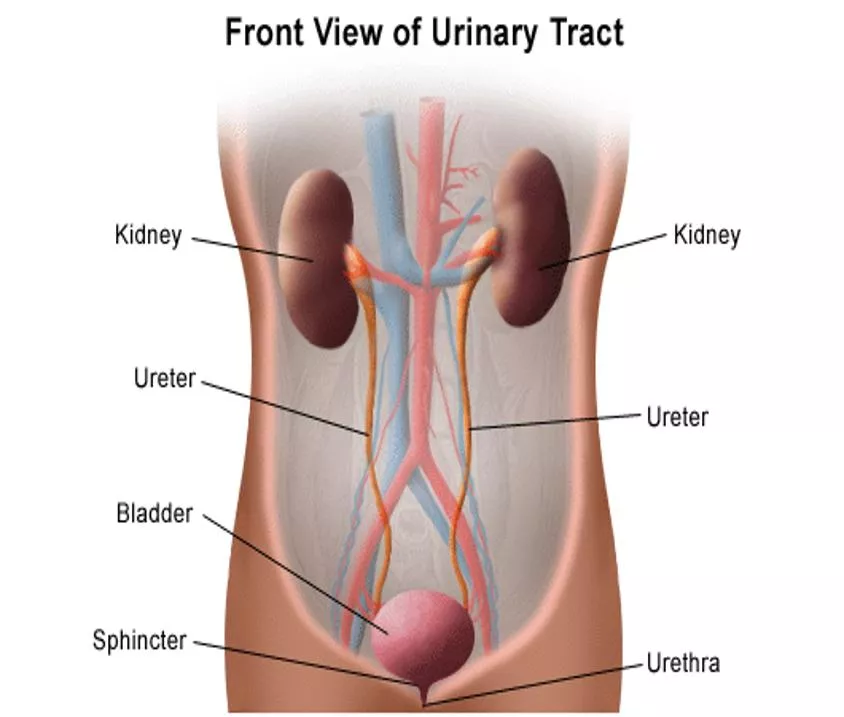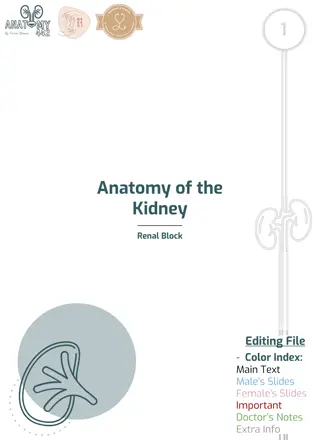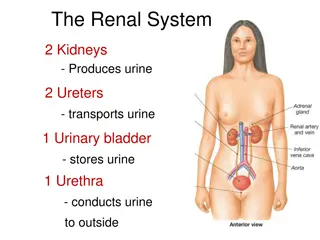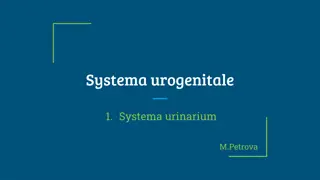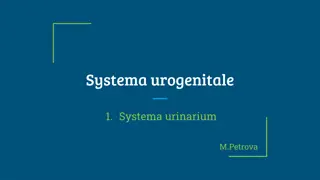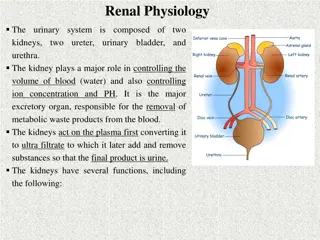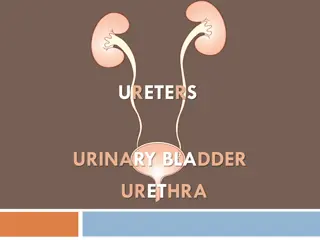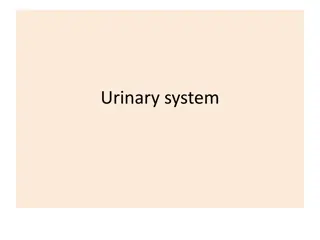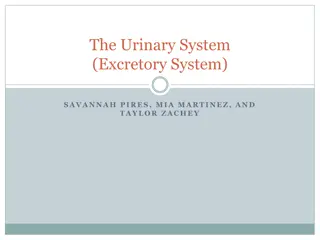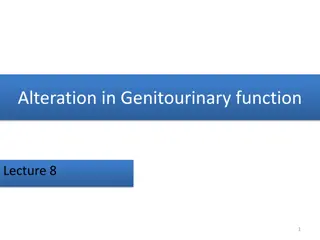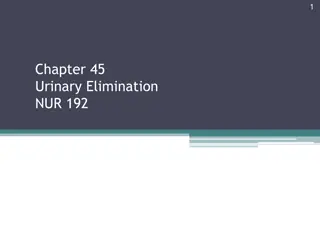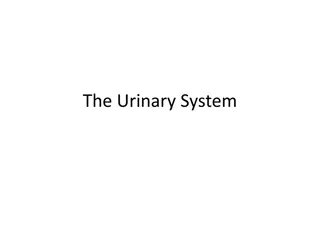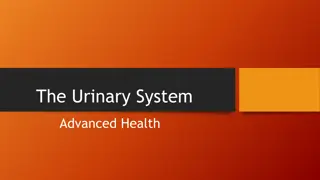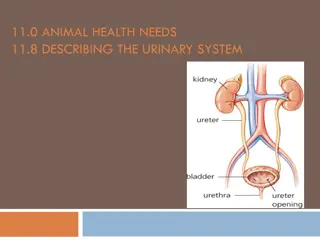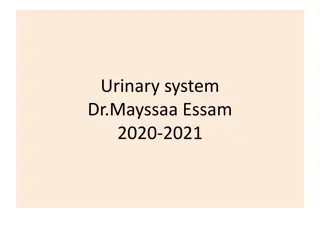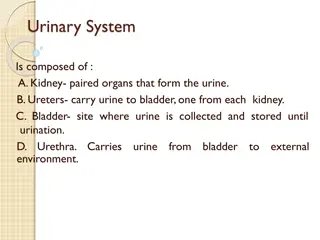Understanding Urinary Elimination: Anatomy, Physiology, and Function of the Kidneys
The lecture covers the fundamentals of urinary elimination focusing on the kidneys' location, structure, function, and the role of nephrons. It discusses the transport of urine through the ureters to the bladder, highlighting the bladder's muscle layers and the urethra's role in expelling urine. Students learn about maintaining fluid balance, waste removal, blood pressure regulation, and erythropoietin secretion by the kidneys.
Download Presentation

Please find below an Image/Link to download the presentation.
The content on the website is provided AS IS for your information and personal use only. It may not be sold, licensed, or shared on other websites without obtaining consent from the author. Download presentation by click this link. If you encounter any issues during the download, it is possible that the publisher has removed the file from their server.
E N D
Presentation Transcript
Fundamentals of Nursing (1st Stage) Second Semester/ 2022-2023 Urinary Elimination Urinary Elimination Lecture 3: Theory Part I University of Basrah College of Nursing Fundamentals of Nursing Department
Anatomy And Physiology Anatomy And Physiology Location of the Kidneys: The kidneys are located on either side of the vertebral column behind the peritoneum, in the upper abdominal cavity. University of Basrah College of Nursing Fundamentals of Nursing Department 2
Anatomy And Physiology Anatomy And Physiology Functions of the Kidneys: 1- Help maintain Fluid balance. 2- Nephrons remove the end products of metabolism, such as urea, creatinine, and uric acid from the blood plasma and form urine. 3- Regulate blood pressure. 4- Secrete Erythropoietin hormone that stimulate bone marrow produce RBC. University of Basrah College of Nursing Fundamentals of Nursing Department 2
The nephron is the basic structural and functional unit of the kidneys. There are about 1 million nephrons in each kidney. Once formed, urine from the nephrons empties into the pelvis of each kidney. From each kidney, urine is transported by rhythmic peristalsis through the ureters to the urinary bladder. The ureters enter the bladder obliquely. A fold of membrane in the bladder closes the entrance to the ureters so that urine is not forced up the ureters to the kidneys when pressure exists in the bladder. University of Basrah College of Nursing Fundamentals of Nursing Department 4
University of Basrah College of Nursing Fundamentals of Nursing Department 5
Bladder Bladder The urinary bladder is a smooth muscle sac that serves as a temporary reservoir for urine. It is composed of three layers of muscle tissue: the inner longitudinal layer, the middle circular layer, and the outer longitudinal layer. These three layers are called the detrusor muscle. At the base of the bladder, the middle circular layer of muscle tissue forms the internal, or involuntary, sphincter, which guards the opening between the urinary bladder and the urethra. The urethra conveys urine from the bladder to the exterior of the body. University of Basrah College of Nursing Fundamentals of Nursing Department 6
Urethra Urethra The urethra s function is to transport urine from the bladder to the exterior of the body. The anatomy of the urethra differs in males and females. The male urethra functions in the excretory system and the reproductive system. It is about (13.7 to 16.2 cm) long and consists of three parts: the prostatic, the membranous, and the cavernous portions. University of Basrah College of Nursing Fundamentals of Nursing Department 7
Characteristics Of Urine Characteristic Normal Findings A freshly voided specimen is pale yellow, straw-colored, or amber, depending on its concentration. Normal urine smell is aromatic. As urine stands, it often develops an ammonia odor because of bacterial action. Fresh urine should be clear or translucent; as urine stands and cools, it becomes cloudy. The normal pH is about 6.0, with a range of 4.6 to 8. (Urine alkalinity or acidity may be promoted through diet to inhibit bacterial growth or urinary stone development or to facilitate the therapeutic activity of certain medications.) 1- Color 2- Odor 3- Turbidity 4- pH University of Basrah College of Nursing Fundamentals of Nursing Department 8
Characteristic Normal Findings This is a measure of the concentration of dissolved solids in the urine. The normal range is 1.015 to 1.025. Organic constituents of urine include urea, uric acid, creatinine, hippuric acid, indican, urene pigments, and undetermined nitrogen. Inorganic constituents are ammonia, sodium, chloride, traces of iron, phosphorus, sulfur, potassium, and calcium. 5- Specific gravity 6- Constituents University of Basrah College of Nursing Fundamentals of Nursing Department 9
Terms Used To Describe Urinary Problems Terms Describe 24-hour urine output is less than 50 mL; synonyms are complete kidney shutdown or renal failure Painful or difficult urination Anuria Dysuria Frequency Increased incidence of voiding Glycosuria Presence of sugar in the urine Nocturia Awakening at night to urinate University of Basrah College of Nursing Fundamentals of Nursing Department 10
greatly diminished amount of urine voided in a given time; 24-hour urine output is less than 400 mL Excessive output of urine (diuresis) Oliguria Polyuria Protein in the urine; indication of kidney disease Pus in the urine; urine appears cloudy Proteinuria Pyuria Urgency Strong desire to void Urinary incontinence Involuntary loss of urine University of Basrah College of Nursing Fundamentals of Nursing Department 11
Nursing Process For Urinary Elimination Assessing Collection of data about the patient s voiding patterns, habits, and difficulties and a history of current or past urinary problems. Physical examination of the bladder, if indicated, and urethral meatus; assessment of skin integrity and hydration; and examination of the urine. University of Basrah College of Nursing Fundamentals of Nursing Department 12
Nursing Diagnoses 1. Impaired Urinary Elimination R/T multiple causality manifested by Urinary tract infection. 2. Functional Urinary Incontinence R/T weakened supporting pelvic structure manifested by Neuromuscular impairment. 3. Stress Urinary Incontinence R/T weak pelvic floor muscles manifested by Increase in intra-abdominal pressure . 4. Urinary Retention R/T be developed manifested by Blockage in urinary tract. University of Basrah College of Nursing Fundamentals of Nursing Department 13
Planning Planning Nursing interventions should support planned patient outcomes. The patient will: 1. Produce urine output about equal to fluid intake 2. Maintain fluid and electrolyte balance 3. Empty the bladder completely at regular intervals 4. Report ease of voiding 5. Maintain skin integrity University of Basrah College of Nursing Fundamentals of Nursing Department 14
Implementing Implementing 1. Promoting Normal Urination 2. Maintaining Normal Voiding Habits 3. Promoting Fluid Intake 4. Strengthening Muscle Tone University of Basrah College of Nursing Fundamentals of Nursing Department 15
Fundamentals of Nursing(1st Stage) Second Semester/ 2022-2023 Bowel Elimination Lecture 3: Theory Part II
Introduction The digestive system is made up of the gastrointestinal tract also called the GI tract or digestive tract and the liver, pancreas, and gallbladder. The GI tract is a series of hollow organs joined in a long, twisting tube from the mouth to the anus. The hollow organs that make up the GI tract are the mouth, esophagus, stomach, small intestine, large intestine, and anus. The liver, pancreas, and gallbladder are the solid organs of the digestive system. University of Basrah College of Nursing Fundamentals of Nursing Department
Large/Small Intestine Small Intestine: Secretes enzymes aiding in protein and carb digestion 3 Parts: duodenum, jejunum & ileum Functions-Receive liver and pancreas s juices for digestion- Food digestion and nutrient absorption in the bloodstream University of Basrah College of Nursing Fundamentals of Nursing Department
large intestine The primary organ of bowel elimination, is the lower, or distal, part of the gastrointestinal tract. The large intestine, also known as the colon, extends from the ileocecal valve to the anus. The colon in adults is about 1.5 m long, but variations in length are normal. University of Basrah College of Nursing Fundamentals of Nursing Department
University of Basrah College of Nursing Fundamentals of Nursing Department
Ileocolic valve. The connection between the ileum of the small intestine and the large intestine. This valve normally prevents contents from entering the large intestine prematurely and prevents waste products from returning to the small intestine. University of Basrah College of Nursing Fundamentals of Nursing Department
The cecum, is first part of the large intestine, the digestive contents enter the colon, which consists of several segments. University of Basrah College of Nursing Fundamentals of Nursing Department
The ascending colon extends from the cecum upward toward the liver, where it turns to cross the abdomen. This turn is called the hepatic flexure. University of Basrah College of Nursing Fundamentals of Nursing Department
Upon turning, this portion of the colon becomes the transverse colon, crossing the abdomen from right to left. The colon then turns at the splenic flexure to become the descending colon. The descending colon passes down the left side of the body to the sigmoid, or pelvic, colon. The sigmoid colon contains feces, solid waste products. Feces are excreted from the rectum through the anal canal, and out an opening called the anus. University of Basrah College of Nursing Fundamentals of Nursing Department
Functions of the large intestine 1. Absorption of water 2. Formation and Expulsion of feces 3. Bacteria that reside in the large intestine act on food residue while it makes its way through the large intestine. 4. Bacterial action produces vitamin K and some of the B- complex vitamins. University of Basrah College of Nursing Fundamentals of Nursing Department
Elimination Elimination is the process of expelling solid wastes made up of the waste products of food that are not absorbed into the cells of the body. Two centers govern the reflex to eliminate, in the medulla and a spinal cord. University of Basrah College of Nursing Fundamentals of Nursing Department
Factors Affecting Bowel Elimination 1- Developmental Considerations. 2- Daily patterns. 3- Food and Fluid. 4- Activity and Muscle Tone. 5- Lifestyle. 6- Psychological Variables. 7- Pathologic Conditions 8- Medications 9- Diagnostic Studies 10-Surgery and Anesthesia University of Basrah College of Nursing Fundamentals of Nursing Department
Constipation Constipation occurs when bowel movements become less frequent and stools become difficult to pass.
Nursing Interventions 1. Encourage the patient to increase fluid intake of 1.5 to 2 L/day 2. Advised patients to take the recommended dose of dietary fiber of at least 20 to 30 g daily. Encourage intake of prune juice. 3. Assist the patient in doing physical activity and exercise. Consider isometric abdominal and gluteal exercises. 4. Institute a toilet schedule or bowel training as appropriate. 5. Provide warm Sitz baths as indicated 6. Use as ordered Stimulant laxatives (e.g., Bisacodyl, Castor Oil ) University of Basrah College of Nursing Fundamentals of Nursing Department
Diarrhea Diarrhea: More frequent bowel movements is a common problem. It may be present alone or be associated with other symptoms, such as nausea, vomiting, abdominal pain or weight loss. University of Basrah College of Nursing Fundamentals of Nursing Department
Nursing Diagnosis 1) Deficient Fluid Volume and Imbalanced Nutrition: Less Than Body Requirements 2) Impaired Skin Integrity 3) Self-Care Deficit University of Basrah College of Nursing Fundamentals of Nursing Department
Nursing Interventions 1. Weigh patient daily and note decreased weight. 2. Have patient keep a diary that includes the following: time of day defecation occurs; usual stimulus for defecation; consistency, amount, and frequency of stool. 3. Avoid using medications that slow peristalsis. 4. Give antidiarrheal drugs as ordered. University of Basrah College of Nursing Fundamentals of Nursing Department
5. Record number and consistency of stools per day. 6. Evaluate dehydration by observing skin turgor over sternum and inspecting for longitudinal furrows of the tongue. Watch for excessive thirst, fever, dizziness, lightheadedness, palpitations, excessive cramping, bloody stools, hypotension, and symptoms of shock. 7. Encourage fluids 1.5 to 2 L/24 hr plus 200 mL for each loose stool in adults unless contraindicated; consider nutritional support. 8. Monitor and record intake and output; note oliguria and dark, concentrated urine.
University of Basrah College of Nursing Fundamentals of Nursing Department 21














